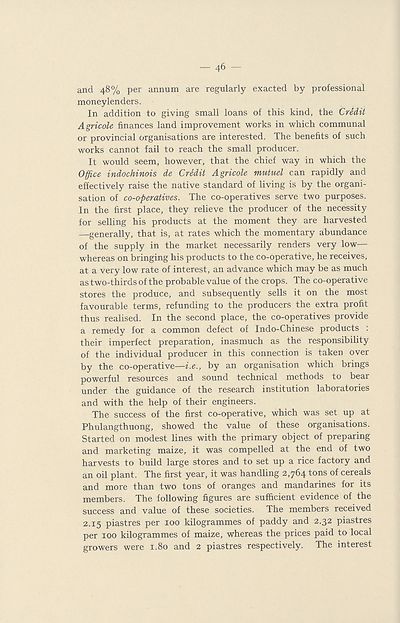Health > Intergovernmental conference of Far-Eastern countries on rural hygiene : preparatory papers : report of French Indo-China
(48)
Download files
Complete book:
Individual page:
Thumbnail gallery: Grid view | List view

- 46 -
and 48% per annum are regularly exacted by professional
moneylenders.
In addition to giving small loans of this kind, the Credit
Agricole finances land improvement works in which communal
or provincial organisations are interested. The benefits of such
works cannot fail to reach the small producer.
It would seem, however, that the chief way in which the
Office indochinois de Credit Agricole niutuel can rapidly and
effectively raise the native standard of living is by the organi¬
sation of co-operatives. The co-operatives serve two purposes.
In the first place, they relieve the producer of the necessity
for selling his products at the moment they are harvested
—generally, that is, at rates which the momentary abundance
of the supply in the market necessarily renders very low—
whereas on bringing his products to the co-operative, he receives,
at a very low rate of interest, an advance which may be as much
as two-thirds of the probable value of the crops. The co-operative
stores the produce, and subsequently sells it on the most
favourable terms, refunding to the producers the extra profit
thus realised. In the second place, the co-operatives provide
a remedy for a common defect of Indo-Chinese products :
their imperfect preparation, inasmuch as the responsibility
of the individual producer in this connection is taken over
by the co-operative—i.e., by an organisation which brings
powerful resources and sound technical methods to bear
under the guidance of the research institution laboratories
and with the help of their engineers.
The success of the first co-operative, which was set up at
Phulangthuong, showed the value of these organisations.
Started on modest lines with the primary object of preparing
and marketing maize, it was compelled at the end of two
harvests to build large stores and to set up a rice factory and
an oil plant. The first year, it was handling 2,764 tons of cereals
and more than two tons of oranges and mandarines for its
members. The following figures are sufficient evidence of the
success and value of these societies. The members received
2.15 piastres per 100 kilogrammes of paddy and 2.32 piastres
per 100 kilogrammes of maize, whereas the prices paid to local
growers were 1.80 and 2 piastres respectively. The interest
and 48% per annum are regularly exacted by professional
moneylenders.
In addition to giving small loans of this kind, the Credit
Agricole finances land improvement works in which communal
or provincial organisations are interested. The benefits of such
works cannot fail to reach the small producer.
It would seem, however, that the chief way in which the
Office indochinois de Credit Agricole niutuel can rapidly and
effectively raise the native standard of living is by the organi¬
sation of co-operatives. The co-operatives serve two purposes.
In the first place, they relieve the producer of the necessity
for selling his products at the moment they are harvested
—generally, that is, at rates which the momentary abundance
of the supply in the market necessarily renders very low—
whereas on bringing his products to the co-operative, he receives,
at a very low rate of interest, an advance which may be as much
as two-thirds of the probable value of the crops. The co-operative
stores the produce, and subsequently sells it on the most
favourable terms, refunding to the producers the extra profit
thus realised. In the second place, the co-operatives provide
a remedy for a common defect of Indo-Chinese products :
their imperfect preparation, inasmuch as the responsibility
of the individual producer in this connection is taken over
by the co-operative—i.e., by an organisation which brings
powerful resources and sound technical methods to bear
under the guidance of the research institution laboratories
and with the help of their engineers.
The success of the first co-operative, which was set up at
Phulangthuong, showed the value of these organisations.
Started on modest lines with the primary object of preparing
and marketing maize, it was compelled at the end of two
harvests to build large stores and to set up a rice factory and
an oil plant. The first year, it was handling 2,764 tons of cereals
and more than two tons of oranges and mandarines for its
members. The following figures are sufficient evidence of the
success and value of these societies. The members received
2.15 piastres per 100 kilogrammes of paddy and 2.32 piastres
per 100 kilogrammes of maize, whereas the prices paid to local
growers were 1.80 and 2 piastres respectively. The interest
Set display mode to:
![]() Universal Viewer |
Universal Viewer | ![]() Mirador |
Large image | Transcription
Mirador |
Large image | Transcription
Images and transcriptions on this page, including medium image downloads, may be used under the Creative Commons Attribution 4.0 International Licence unless otherwise stated. ![]()
| League of Nations > Health > Intergovernmental conference of Far-Eastern countries on rural hygiene : preparatory papers : report of French Indo-China > (48) |
|---|
| Permanent URL | https://digital.nls.uk/191085085 |
|---|
| Shelfmark | LN.III |
|---|---|
| Description | Over 1,200 documents from the non-political organs of the League of Nations that dealt with health, disarmament, economic and financial matters for the duration of the League (1919-1945). Also online are statistical bulletins, essential facts, and an overview of the League by the first Secretary General, Sir Eric Drummond. These items are part of the Official Publications collection at the National Library of Scotland. |
|---|---|
| Additional NLS resources: |
|

